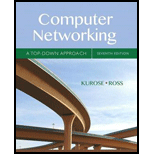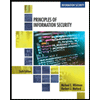
Computer Networking: A Top-Down Approach (7th Edition)
7th Edition
ISBN: 9780133594140
Author: James Kurose, Keith Ross
Publisher: PEARSON
expand_more
expand_more
format_list_bulleted
Expert Solution & Answer
Chapter 3, Problem R1RQ
a)
Explanation of Solution
Step-by-step process of designing the simplest possible transport-layer protocol:
The STP (Simple Transport Protocol) takes for the process. The protocol takes the data not exceeding 1196 bytes at the sender side.
- The protocol accepts the four byte destination port number, host address, and a destination port address as a chunk which is not exceeding 1196 bytes.
- STP adds a four-byte header to each chunk and puts the port number of the destination in this header.
- The protocol then gives the destination host address and the resulting segment to the network layer.
- After receiving the address and segment, the network layer send the segment to STP at the destination host.
- STP then examines the segment and observes its port number and then the protocol extracts the data from the segment.
- The extracted data passes to the process of identified port number.
b)
Explanation of Solution
Modification:
Consider the segment has two header fields: one is “source port field” and another one is “destination port field”.
- At the source side, STP accepts the chunk of data which is not exceeding 1192 bytes. The data has destination host address, source port number, and a destination port number.
- Then, STP creates a segment which has application data, source port number, and destination port number.
- After creating segment, STP gives the two values to the network layer. They are: segment and destination port number.
- Then the STP receives host address and provides the process the source port number and the application data.
c)
Explanation of Solution
“No”, the transport layer does not do anything in the core of the
Explanation:
The reason is that the transport layer “lives” in the end systems.
Want to see more full solutions like this?
Subscribe now to access step-by-step solutions to millions of textbook problems written by subject matter experts!
Students have asked these similar questions
2:21 m
Ο
21%
AlmaNet
WE ARE
HIRING
Experienced Freshers
Salesforce
Platform
Developer
APPLY NOW
SEND YOUR CV:
Email: hr.almanet@gmail.com
Contact: +91 6264643660
Visit: www.almanet.in
Locations: India, USA, UK, Vietnam
(Remote & Hybrid Options Available)
Provide a detailed explanation of the architecture on the diagram
hello please explain the architecture in the diagram below. thanks you
Chapter 3 Solutions
Computer Networking: A Top-Down Approach (7th Edition)
Ch. 3 - Prob. R1RQCh. 3 - Prob. R2RQCh. 3 - Consider a TCP connection between Host A and Host...Ch. 3 - Prob. R4RQCh. 3 - Prob. R5RQCh. 3 - Prob. R6RQCh. 3 - Suppose a process in Host C has a UDP socket with...Ch. 3 - Prob. R8RQCh. 3 - Prob. R9RQCh. 3 - In our rdt protocols, why did we need to introduce...
Ch. 3 - Prob. R11RQCh. 3 - Prob. R12RQCh. 3 - Prob. R13RQCh. 3 - Prob. R14RQCh. 3 - Suppose Host A sends two TCP segments back to back...Ch. 3 - Prob. R16RQCh. 3 - Prob. R17RQCh. 3 - Prob. R18RQCh. 3 - Prob. R19RQCh. 3 - Prob. P1PCh. 3 - Prob. P2PCh. 3 - UDP and TCP use 1s complement for their checksums....Ch. 3 - Prob. P4PCh. 3 - Prob. P5PCh. 3 - Prob. P6PCh. 3 - Prob. P7PCh. 3 - Prob. P8PCh. 3 - Prob. P9PCh. 3 - Prob. P10PCh. 3 - Prob. P11PCh. 3 - Prob. P12PCh. 3 - Prob. P13PCh. 3 - Prob. P14PCh. 3 - Prob. P15PCh. 3 - Prob. P16PCh. 3 - Prob. P17PCh. 3 - Prob. P21PCh. 3 - Prob. P22PCh. 3 - Prob. P25PCh. 3 - Prob. P26PCh. 3 - Prob. P27PCh. 3 - Host A and B are directly connected with a 100...Ch. 3 - Prob. P29PCh. 3 - Prob. P30PCh. 3 - Prob. P31PCh. 3 - Prob. P33PCh. 3 - Prob. P34PCh. 3 - Prob. P35PCh. 3 - Prob. P37PCh. 3 - Prob. P38PCh. 3 - Prob. P39PCh. 3 - Prob. P41PCh. 3 - Prob. P42PCh. 3 - Prob. P43PCh. 3 - Prob. P44PCh. 3 - Prob. P45PCh. 3 - Prob. P46PCh. 3 - Prob. P47PCh. 3 - Prob. P48PCh. 3 - Prob. P49PCh. 3 - Prob. P51PCh. 3 - Prob. P53PCh. 3 - Prob. P55P
Knowledge Booster
Similar questions
- Complete the JavaScript function addPixels () to calculate the sum of pixelAmount and the given element's cssProperty value, and return the new "px" value. Ex: If helloElem's width is 150px, then calling addPixels (hello Elem, "width", 50) should return 150px + 50px = "200px". SHOW EXPECTED HTML JavaScript 1 function addPixels (element, cssProperty, pixelAmount) { 2 3 /* Your solution goes here *1 4 } 5 6 const helloElem = document.querySelector("# helloMessage"); 7 const newVal = addPixels (helloElem, "width", 50); 8 helloElem.style.setProperty("width", newVal); [arrow_forwardSolve in MATLABarrow_forwardHello please look at the attached picture. I need an detailed explanation of the architecturearrow_forward
- Information Security Risk and Vulnerability Assessment 1- Which TCP/IP protocol is used to convert the IP address to the Mac address? Explain 2-What popular switch feature allows you to create communication boundaries between systems connected to the switch3- what types of vulnerability directly related to the programmer of the software?4- Who ensures the entity implements appropriate security controls to protect an asset? Please do not use AI and add refrencearrow_forwardFind the voltage V0 across the 4K resistor using the mesh method or nodal analysis. Note: I have already simulated it and the value it should give is -1.714Varrow_forwardResolver por superposicionarrow_forward
- Describe three (3) Multiplexing techniques common for fiber optic linksarrow_forwardCould you help me to know features of the following concepts: - commercial CA - memory integrity - WMI filterarrow_forwardBriefly describe the issues involved in using ATM technology in Local Area Networksarrow_forward
- For this question you will perform two levels of quicksort on an array containing these numbers: 59 41 61 73 43 57 50 13 96 88 42 77 27 95 32 89 In the first blank, enter the array contents after the top level partition. In the second blank, enter the array contents after one more partition of the left-hand subarray resulting from the first partition. In the third blank, enter the array contents after one more partition of the right-hand subarray resulting from the first partition. Print the numbers with a single space between them. Use the algorithm we covered in class, in which the first element of the subarray is the partition value. Question 1 options: Blank # 1 Blank # 2 Blank # 3arrow_forward1. Transform the E-R diagram into a set of relations. Country_of Agent ID Agent H Holds Is_Reponsible_for Consignment Number $ Value May Contain Consignment Transports Container Destination Ф R Goes Off Container Number Size Vessel Voyage Registry Vessel ID Voyage_ID Tonnagearrow_forwardI want to solve 13.2 using matlab please helparrow_forward
arrow_back_ios
SEE MORE QUESTIONS
arrow_forward_ios
Recommended textbooks for you
 Systems ArchitectureComputer ScienceISBN:9781305080195Author:Stephen D. BurdPublisher:Cengage Learning
Systems ArchitectureComputer ScienceISBN:9781305080195Author:Stephen D. BurdPublisher:Cengage Learning Principles of Information Security (MindTap Cours...Computer ScienceISBN:9781337102063Author:Michael E. Whitman, Herbert J. MattordPublisher:Cengage Learning
Principles of Information Security (MindTap Cours...Computer ScienceISBN:9781337102063Author:Michael E. Whitman, Herbert J. MattordPublisher:Cengage Learning Principles of Information Systems (MindTap Course...Computer ScienceISBN:9781305971776Author:Ralph Stair, George ReynoldsPublisher:Cengage Learning
Principles of Information Systems (MindTap Course...Computer ScienceISBN:9781305971776Author:Ralph Stair, George ReynoldsPublisher:Cengage Learning Fundamentals of Information SystemsComputer ScienceISBN:9781337097536Author:Ralph Stair, George ReynoldsPublisher:Cengage Learning
Fundamentals of Information SystemsComputer ScienceISBN:9781337097536Author:Ralph Stair, George ReynoldsPublisher:Cengage Learning A+ Guide To It Technical SupportComputer ScienceISBN:9780357108291Author:ANDREWS, Jean.Publisher:Cengage,
A+ Guide To It Technical SupportComputer ScienceISBN:9780357108291Author:ANDREWS, Jean.Publisher:Cengage, Principles of Information Systems (MindTap Course...Computer ScienceISBN:9781285867168Author:Ralph Stair, George ReynoldsPublisher:Cengage Learning
Principles of Information Systems (MindTap Course...Computer ScienceISBN:9781285867168Author:Ralph Stair, George ReynoldsPublisher:Cengage Learning

Systems Architecture
Computer Science
ISBN:9781305080195
Author:Stephen D. Burd
Publisher:Cengage Learning

Principles of Information Security (MindTap Cours...
Computer Science
ISBN:9781337102063
Author:Michael E. Whitman, Herbert J. Mattord
Publisher:Cengage Learning

Principles of Information Systems (MindTap Course...
Computer Science
ISBN:9781305971776
Author:Ralph Stair, George Reynolds
Publisher:Cengage Learning

Fundamentals of Information Systems
Computer Science
ISBN:9781337097536
Author:Ralph Stair, George Reynolds
Publisher:Cengage Learning

A+ Guide To It Technical Support
Computer Science
ISBN:9780357108291
Author:ANDREWS, Jean.
Publisher:Cengage,

Principles of Information Systems (MindTap Course...
Computer Science
ISBN:9781285867168
Author:Ralph Stair, George Reynolds
Publisher:Cengage Learning